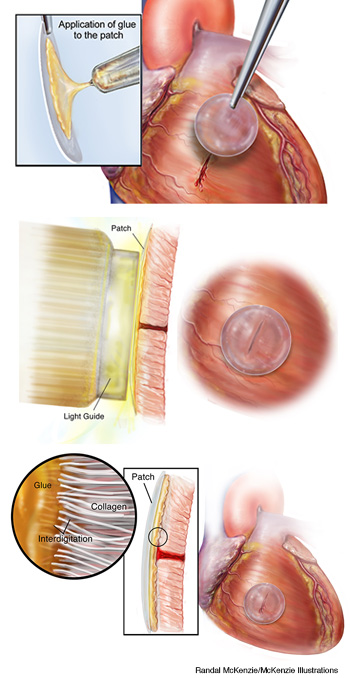
In the first step of heart repair, a surgeon applies the hydrophobic, light-activated adhesive to a biodegradable patch (top). Next, UV light activates the glue and promotes adhesion between the patch and the patient's tissue (middle). Finally, the glue and collagen fibers in the heart tissue interlock for optimal adhesion (bottom)
To make surgical heart repairs less invasive, surgeons need tools and materials that can work in confined, wet spaces. A team of physicians and biomedical engineers based in Massachusetts (U.S.A.) has developed a light-activated glue that binds to blood-vessel walls and beating heart tissue (Sci. Transl. Med. 6, 218ra6).
The glue, a blend of two naturally occurring substances, creates an adhesive bond with as little as 5 s of exposure to an ultraviolet light source, and would gradually biodegrade as the patient's tissue grows over the repair site, says Jeffrey M. Karp, associate professor at Harvard Medical School and Brigham and Women's Hospital (BWH) in Boston, one of the study’s authors.
Today's clinical adhesives, such as medical-grade cyanoacrylate (a sterilized version of commercially available glue), are hydrophilic and stick best to dry tissues, according to Karp. The materials also wash off quickly in so-called dynamic environments, such as the constant motion of cardiac tissue.
The adhesive developed by Karp's team is a pre-polymer called poly(glycerol sebacate acrylate), or PGSA, a mix of glycerol (C3H8O3) and sebacic acid (C10H18O4). Karp says that the scientists were inspired by the viscous, hydrophobic secretions of some animals, such as slugs. The team also wanted a material that would be injectable and easy to work with in an environment saturated with blood.
In the presence of a small amount of commercial photoinitiator, the adhesive was cured with UV light (wavelengths 320-390 nm) at an intensity of 0.38 W/cm2 through a light pipe. The photoinitator generates a free radical that binds the chains of the polymers together within the adhesive, according to Karp.
The surgical glue will degrade over a period of months, but should last long enough for the patient's tissue to grow over the repair site. Karp says the adhesive could work in other types of minimally invasive surgery.
Researchers at Boston Children's Hospital (BCH) and the Massachusetts Institute of Technology also participated in the study, led by Nora Lang of BCH and Maria Pereira of BWH. So far, the group has tested the adhesive only in the laboratory and on pigs, but the scientists are working with a French startup company to begin clinical trials of the adhesive in Europe, where the regulatory process typically is faster than in the United States.
